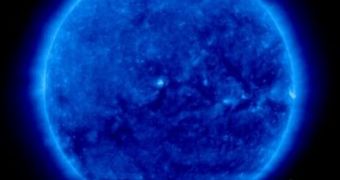Following the steps of their fellow colleagues form the European Space Agency, NASA also has in plan to implement a program to predict the space weather determined by the activity of the closest star to Earth - the Sun. Lying just over 150 million kilometer from Earth, the Sun, with a diameter about 100 times that of our planet, provides us with one of the most important ingredients to the appearance and evolution of life: light. The total energy radiated from the Sun in one second, in the form of light, is enough to power the whole planet for at least one million years, fact which also explains why physicists around the world are currently concentrating in creating a functional nuclear fusion reactor.
But the Sun, similar to other stars, does not emit only light during the nuclear fusion process. Massive amounts of matter, in the form of highly energetic elementary particles, are being ejected into interstellar space every second, to create what we call the solar wind. If it weren't for Earth's powerful magnetic field, the electric grids and all other electrical and electronic systems would cease to function within an instant, not to mention about the effects such action would have on living beings on our planet.
Fortunately, the Earth is protected for now. The same cannot be said about the volume outside the Earth's protective sphere, which is filled with deadly radiation. NASA's Solar Dynamics Observatory, or SDO, is scheduled to launch sometime at the end of this year, in order to monitor the solar activity and make a direct correlation with the severe space weather effects it determines.
To this date, multiple space agencies already have established a grid of probes constantly monitoring the Sun, amongst which the ESA and NASA. Albeit, Dr Dean Pesnell from the Goddard Space Flight Center believes that even those are not enough to make accurate space weather predictions. The SDO, on the other hand, might just do the job.
Nuclear fusion reactions taking place deep inside the Sun's core produce a massive amount of energy, radiated towards the outer layers either in the form of light or heat, which, when it reaches the surface, disturbs the apparent quiet surface of the Sun in a way similar to that of boiling water. Electrically charged plasma determines the appearance of powerful magnetic fields of the surface, which, in turn, interact with the plasma. Eventually, some looped magnetic field would stretch too far of the Sun's surface and snap in order to release the excess energy in the form of solar flares or coronal mass ejections.
A single solar flare occurring on the Sun's surface could pack energy as high as one megaton nuclear bomb, throwing up to a couple billions of tons of plasma into interstellar space, at speeds exceeding one million kilometers per hour. We are currently in a calm period of solar activity, but things may change drastically within the next five years or so, when the next solar activity peak will take place.
Magnetic fields are a key component within the solar activity, as they help plasma circulate and dissipate the energy received from within the solar core. It is well known that the solar cycle takes about 11 years to complete, which is a valuable information, but there are still many aspects of the solar activity that cannot be accurately predicted, such as the solar flares, for example. SDO with its Helioseismic and Magnetic Imager instrument will be able to basically take a peek inside the Sun to create images of the plasma flows to finally reveal what mechanism determines that 11 years solar cycle.
By studying the Sun's atmosphere, the Atmospheric Imaging Assembly instrument could observe sudden changes in the magnetic fields occurring on the surface, and correlate the data with that extracted by the HMI to produce an even better model of the processes which take place inside the Sun and accurately predict when a solar storm might take place. The third instrument on board the SDO spacecraft is the Extreme Ultraviolet Variability Experiment, that will have the role of measuring the amount of ultraviolet light emitted from the Sun. An increase in ultraviolet brightness ultimately translates into an increase of matter ejection processes from the surface and atmosphere of the Sun, endangering the satellites around Earth into low orbits, as they may be slowed and brought down by Earth's inflating atmosphere, as it receives extra amounts of heat.

 14 DAY TRIAL //
14 DAY TRIAL //